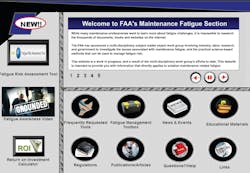The FAA has created a variety of products and tools to support aircraft maintenance organizations. These tools have high potential to help reduce errors, aircraft damage, and employee injuries. The tools help ensure continuing efficient delivery of airworthy aircraft. To determine if you are taking advantage of these FAA products you can answer yes or no to the questions below. Become a “yes man” to using FAA human factors information.
Have you visited the FAA maintenance human factors web site?
All of the FAA maintenance human factors products are available at the shortened web site address: mxfatigue.com. If you have not been there, you are missing out on a number of free high value human factors resources.
Another great source of information is www.faasafety.gov. Maintained by the FAA Safety Team, that site offers many online courses, access to CDs, and information about safety events in your area, including IA renewal seminars.
Are you using FAA human factors training materials?
There are plenty of widely used FAA human factors training products. The Maintenance Human Factors Presentation System (MHFPS) (See Figure 2) offers 150 PowerPoint slides, 12 short videos, and 50 animated files that can comprise an entire human factors training program to be delivered by your instructor. Many human factors training consultants have adopted the FAA human factors training materials. You may be using it without even knowing its origin. Since 2008, the FAA has sent out more than 12,000 MHFPS in response to individual email requests from the human factors web site.
The FAA Maintenance Fatigue Awareness Training is an interactive web-based training program. Average time to complete the fatigue awareness training is about two hours. It includes an online end-of-course test and will issue a completion certificate. Most users have taken the training via the web but many organizations worldwide have loaded the training on their corporate web site. As one example, Emirate Airlines made the training mandatory for everyone in the maintenance and engineering organization.
The award-winning video, Grounded, see Figure 3, is a fictional story about a fatigued maintenance manager. Available on the web site, on DVD, and even on YouTube, the FAA has lost count on the volume of viewers in 2011-2012. It is integrated with the fatigue countermeasure training.
In 2011 and 2012 an estimated 20,000 visitors to the FAA Safety Team web site (FAAsafety.gov) completed the fatigue training. One MRO conducted an extensive cost-benefit analysis on the fatigue training. From 2010 through 2011 the organization reported achieving a savings of more than $300K just by reducing fatigue-related error (See below for more details).
FAA HF training offerings continue. In January 2013, the FAA launched another web-based training entitled, Human Factors Primer for Aviation Mechanics. That HF training will be a core course for the FAA Diamond Award. The course focuses on how attention to human factors can also promote a corporate and individual safety commitment to “Zero Violations.”
Are you using the HF support materials?
Training is a key ingredient to affect employee knowledge and behavior. But training is not enough. Training must be reinforced with other organizational programs and promotions. The FAA has put together some products that can help.
The mxfatigue.com has a place to download or order a variety of support materials. For example, there are 12 (See Figure 4 for example) posters to remind workers about fatigue. The posters are pdfs and ready to go to your local printer. For a few hundred dollars many organizations can produce a variety of colorful and informative posters throughout the organization.
The web site has a sleep diary and instructions to help workers assess their own two-week sleep habits. In many cases this is a bold awakening (not a pun) to the fact that one is sleep deprived. The guidance material tells the worker what to do about fatigue.
The online sleep assessment tool asks about 10 questions, regarding sleep and work over a three-day period. The bio-mathematical model instantly tells the worker their estimated level of fatigue and fitness for duty. While this tool has been on line for nearly a year, during 2013 the FAA plans to simplify the input and the output advice to the user.
Have you used the guidance material?
Maintenance personnel and their managers are not excited about reading technical reports and such materials. However, a research and development program certainly must document their activity. Some of that documentation may be a bit scientific. The current FAA team has worked hard to make all reports, newsletters, and other publications as readable and practical as possible. It’s all on the web site. That site has more maintenance human factors materials than any other source worldwide. Nearly 10,000 users per month is testimony to the value of the site and the information therein.
Are you tracking the human errors in maintenance?
Human factors issues are not the sole purpose of voluntary reporting systems. But it is undisputable that human factors contribute to more than 80 percent of events. Voluntary reporting, like the FAA Aviation Safety Action Program (ASAP) (See FAA AC 120-66B) helps individual and organizations document the many small events that may be indicative of increasing risk. Programs, like ASAP, are an important part of a safety culture. Self-reports are often excused from company and/or FAA action. FAA has worked hard to help ensure that event investigations document the human factors that may be contributing factors. One tool that helps categorize human error in maintenance is the Boeing maintenance error decision aid (MEDA). Detailed information on MEDA is available at mxfatigue.com.
Have you tried to cost justify your safety interventions?
Human factors programs have frequently been the first to experience funding reduction when budgets were tight. Today, enlightened managers recognize the financial cost and safety risk associated with human factors. Of course, the corporate financial managers often need a reminder.
The FAA formalized a process and created support tools to help maintenance managers to calculate a safety and financial return-on-investment (ROI) for maintenance human factors interventions. During 2012, a number of aircraft maintenance organizations used the ROI software (available on the web site) (Ground Support Worldwide, October 2011; Aircraft Maintenance Technology, July 2012). Some of the demonstrated returns were in the 1,000 percent plus range (See AeroSafety World, December 2012). Maintenance-oriented users of the ROI software have commented on the ease of use and the quality of the embedded instructions. No one felt that they needed an MBA to translate the financial process into easy estimates and calculations.
Become a “Yes Man”
If you said yes to all of the questions above then congratulations to you. It means that you are from an organization that sees the value in attention to the hazards of human factors. It also means that you strive to use cost-effective solutions to train and motivate your work force. You likely have an excellent and expanding corporate safety culture.
If you could not say yes to all the questions, no problem. It is not too late to start. Go to www.mxfatigue.com and determine which products may work for you. Place your order and you can get started immediately. Become a “Yes Man/Person” when it comes to human factors in your maintenance organization.
Dr. William Johnson spent more than 30 years as senior executive and scientist for engineering companies specializing in technical training and human factors before joining FAA in 2004. He is also an aviation maintenance technician and has been a pilot for more than 45 years.
About the Author

Dr. Bill Johnson
Chief Scientific and Technical Advisor Human Factors in Aviation Maintenance, FAA
““Dr. Bill” Johnson is a familiar name and face to many industry and government aviation audiences. Johnson has been an aviator for over 50 years. He is a pilot, mechanic, scientist/engineer, college professor, and senior executive during his career. That includes 16+ years as the FAA Chief Scientific and Technical Advisor for Human Factors.
Dr. Bill has delivered more than 400 Human Factors speeches and classes in over 50 countries. He has 500 + publications, videos, and other media that serve as the basis for human factors training throughout the world.
Recent significant awards include: The FAA “Charles E. Taylor Master Mechanic” (2020); The Flight Safety Foundation - Airbus “Human Factors in Aviation Safety Award” (2018), and the International Federation of Airworthiness “Sir Francis Whittle Award” (2017).
Starting in 2021 Johnson formed Drbillj.com LLC. In this new venture he continues to bring decades of human factors experience to aviators, worldwide.
